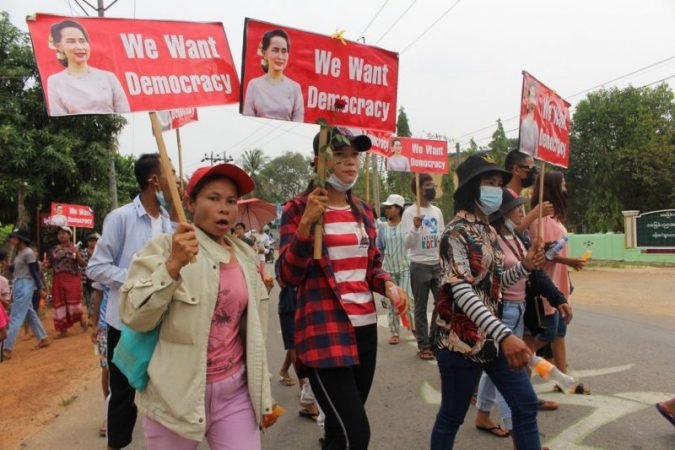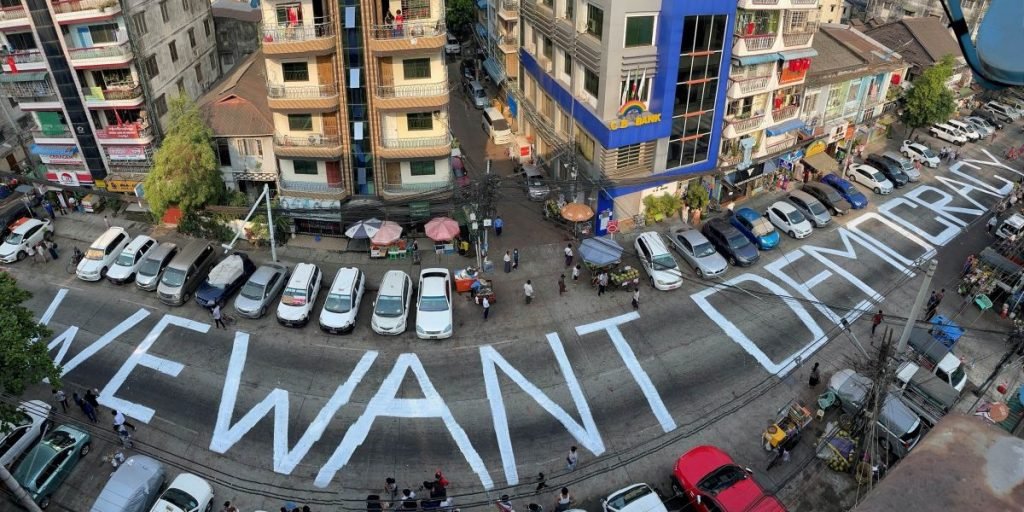Convulsions in Myanmar’s roadmap to democracy

The February 1 coup d’état in Myanmar has left the country in extreme political chaos killing more than 800 people so far. The relative freedom and democratic spirit enjoyed and earned by the country since 2015 is brought to a standstill with the toppling of the NLD government by the military junta. Myanmar, a country with a diverse ethnic presence; which is also the reason for its ethnically volatile socio-political landscape has been fighting against its military since its inception as a sovereign state. The pro-democracy street protest has spread into the remotest rural hinterland. People came out of their homes en masse and have hit the roads pointing the three-finger salute. The protest has earned overwhelming support from every section of the society and established a unity among various ethnic groups who were otherwise at loggerheads involving disparate socio-political-cultural issues. Despite being in unison, the Burmese people’s fight against the junta to reinstate democracy in the country has its own challenges and future prospects.
The Unwinnable battle of democracy
The roadmap to democracy in Myanmar is an uncertain one. The role of Myanmar’s military popularly known as Tatmadaw is extremely dominant in the country’s political space. The Tatmadaw , which considers itself to be the guardian of the nation took over the country’s rule in 1962 for the first time under General Ne Win. The infightings between various ethnic groups regarding just political representation , autonomy and self-determination have helped the Burmese military to exert its influence. The Bamars who are the major ethnic group of Myanmar have dominated and occupied the Burmese socio-political landscape since independence culminating in conflict between other major ethnic minorities such as Kachin, Karen, Shan, Arakan etc., regarding representation. Much of these divisions have religious and political background that resulted in insurgency and armed conflict. After 1962 coup d’état the military government had put strict restrictions on civil rights and institutions. Although 50 years of military rule ended in 2015; but with the February 2021 coup Myanmar’s experiment with democracy came to a halt. The internecine conflict between Myanmar’s civilian government and military has going on in the exact repeating pattern since 1990 i,e through interference in the country’s general elections. Tatmadaw’s ‘Three main national causes” i.e non-disintegration of the union, non-disintegration of national solidarity, and perpetuation of national solidarity is proved to be the greatest boon for its comeback whenever the country try to find its way to democracy. In the 1960s Tatmadaw took over the rule of Myanmar in the name of saving the country from fragmenting into different ethnic lines. The very fact that the inability of Tatmadaw to frame out a solution to its ancient insurgency problem even after 60 years of its independence, inspite of having an all-encompassing , larger-than-needed presence proves how the active faultlines among the ethnic groups is beneficial to keep the military relevant in the country’s political sphere.

After the 2015 Nationwide Ceasefire Amendment (NCA), majority of ethnic armed groups in the present time aspires for greater autonomy and federalism with respect to the socio-political demand of their states. However, the running 2008 military drafted constitution of Myanmar has failed to discuss those concerns. The Aung Saan Syu Kyi’s party National League For Democracy (NLD) emphasized more on democratization of the country over federalism. The controversial 2008 Constitution insured dominant position of military in Myanmar’s politics and bureaucracy with 25% seats reserved in parliament and bringing defense, internal security and border affairs ministries under military. Adding to such draconian code, Article 59 (f) of the constitution bars any person to become a President of the country if their spouse, parents or children are of foreign origin. The article was formulated exclusively to prohibit Aung Saan Syu Kyi to become President as her late husband and children are of British nationality. This article is a groundless existence targeting Syu Kyi because nowhere in the world a citizen of a country is barred from contesting Presidency based on his/her spouse’s and children’s nationality. U Thaung Aye, the former lieutenant-general who formulated the law labelled this article as a victory for the nation for it preserves the sovereignty of the nation in the hands of the ethnics. This article is considered as untouchable in the constitution. The efforts of NLD to amend the constitution and scrap the article is continuously thwarted by military veto. The interfering role of Tatmadaw in Myanmar’s electoral process is another deterrence to the country’s transition to a full democracy. From 1990 to 2020, whenever the country proceeds through a democratic election, the military has refused to recognize it in one way or the other. With such intricacies, Myanmar’s transition to democracy is a hard battle.

A shimmering hope of rare unity.
The coup has certainly unfolded a rare opportunity for the ethnic armed organizations (EAOs) of Myanmar to come together in spirit and fight the military dictatorship. The anti-junta alliances of EAOs are proved to be a terrible predicament to the Tatmadaw. The revolt against the military is different this time. The common protesters are teaming up with the EAOs and forming groups to get arms training especially young people and students. One such militia is People’s Defense Force (PDF) which was formed just after the coup. The offensive fighting between EAOs/ militia groups and the military was concentrated in the rural hinterlands in the beginning but in June 22nd there was a major fighting between PDF and Tatmadaw in Mandalay ( Myanmar’s second largest city). Meanwhile Myanmar’s junta chief Min Aung Hlaing’s visit to Russia amid the ongoing crisis, assuring Russia’s role in bolstering arms trade with the military, is enough to ascertain that the regime is not undermining the threats coming from the anti-junta alliances. Several militia groups like PDF, Three Brotherhood’s Alliance etc are already fighting under alliances either with civilian protestors or small armed groups. However, the alliances between major ethnic armed groups like KNU, KIA, SSA are mutually exclusive. Had those major EAOs teamed up together , the revolt dynamics would’ve been a nemesis to the military. The junta chief’s visit to Russia is a marker here. The coup has unveiled a rare opportunity for the insurgent groups and the common people to come under one umbrella along with NLD’s support. This unity has a prospect of bringing stability to Myanmar by isolating the military from socio-political space in future. Tatmadaw’s greatest strength is not its pervasive influence but the structural faultlines that exists within the Burmese society based on ethnicity and religion. What Burmese society needs more than ever is a strong institutional framework for serious dialogue between its ethnic groups and democratic forces and establishment of rule of law to keep Tatmadaw away from interfering in the electoral processes and gradually isolating them from the politics of the country. Unless a greater unity and consensus is established in the country’s civilian space, the military will forever find its way to comeback making Myanmar’s transition to democracy elusive. The present is the most appropriate time to achieve it.


















